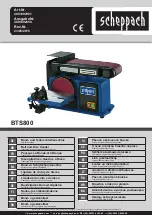
8 - English
OPERATION
INSTALLING ADHESIVE SANDPAPER
See Figure 1, page 11.
Unplug the sander.
If replacing adhesive sandpaper, remove old sandpaper
by peeling it off cushion.
NOTE: Sand for a few minutes to soften the adhesive
backing before attempting to remove old sandpaper.
If replacing regular sandpaper, release paper clamp by
lifting up on lever and disengaging it from the tab on the
platen. Remove non-adhesive sandpaper, then lift up on
paper clamp lever and lock it into place.
Carefully peel adhesive backing from new 1/4 sheet
sandpaper.
Position sandpaper, making sure front edge of sandpaper
is aligned with front edge of the cushion, then carefully
press sticky side of sandpaper on cushion.
NOTE: Sandpaper must be aligned with the front edge
of the cushion for proper functioning of the flush sanding
feature.
NOTE: The cushion on the sander is approximately 1/4 in.
smaller than precut adhesive-backed sanding sheets. If
desired you may want to trim off the overhang of sandpaper
on the back side of cushion. The cushion has been made
smaller so that multiple sheets of non-adhesive sandpaper
can be installed.
PAPER PUNCH
See Figure 2, page 11.
A paper punch template has been supplied with the sander for
aligning and punching holes in sandpaper. The punched holes
must align with the holes in the sander cushion. Punching
the holes properly is a necessary step for dustless sanding.
Install sandpaper on the sander.
Align sander cushion to paper punch as shown.
Push down on sander.
WARNING:
Always wear safety goggles or safety glasses with side
shields when operating your sander. Failure to do so
could result in foreign objects being thrown into your
eyes resulting in possible serious injury. If the sanding
operating is dusty, also wear a face or dust mask.
SANDPAPER SELECTION
Selecting the correct size grit and type sandpaper is an
extremely important step in achieving a high quality sanded
finish. Aluminum oxide, silicon carbide, and other synthetic
abrasives are best for power sanding. Natural abrasives,
such as flint and garnet are too soft for economical use in
power sanding.
In general, coarse grit will remove the most material and finer
grit will produce the best finish in all sanding operations. The
condition of the surface to be sanded will determine which
grit will do the job. If the surface is rough, start with a coarse
grit and sand until the surface is uniform. Medium grit may
then be used to remove scratches left by the coarser grit and
finer grit used for finishing of the surface. Always continue
sanding with each grit until surface is uniform.
NOTE: DO NOT use sander without sandpaper. Doing so
will damage the cushion.
CAUTION:
Be careful not to let your hand completely cover air vents.
SANDING
See Figures 3 - 4, pages 11 and 12.
Clamp or otherwise secure the work to prevent it from mov-
ing under the sander.
WARNING:
Unsecured work could be thrown towards the operator
causing injury.
Hold the sander in front and away from you, keeping it clear
of the workpiece. Start the sander by pressing the switch
button to “ON” position and letting the motor build to its
maximum speed. Gradually lower the sander on the work
with a slight forward movement. Move it slowly using forward
and backward strokes.
Do not force. The weight of the unit supplies adequate
pressure, so let the sandpaper and sander do the work.
Applying additional pressure only slows the motor, rapidly
wears sandpaper, and greatly reduces sander speed.
Excessive pressure will overload the motor causing possible
damage from motor overheating and can result in inferior
work. Any finish or resin on wood may soften from the fric-
tional heat. Do not allow sanding on one spot too long as
the sander’s rapid action may remove too much material,
making the surface uneven.
Flush sanding can be performed with the sander. The front
edge of the sander allows flush sanding in corners. Always
remove the sander from the workpiece before turning the
sander off.
WARNING:
Do not wear loose clothing or jewelry when operating
sander. They could get caught in moving parts causing
serious injury. Keep head away from sander and sanding
area. Hair could be drawn into sander causing serious
injury.
Summary of Contents for S652D
Page 31: ...13 NOTES NOTAS...









































